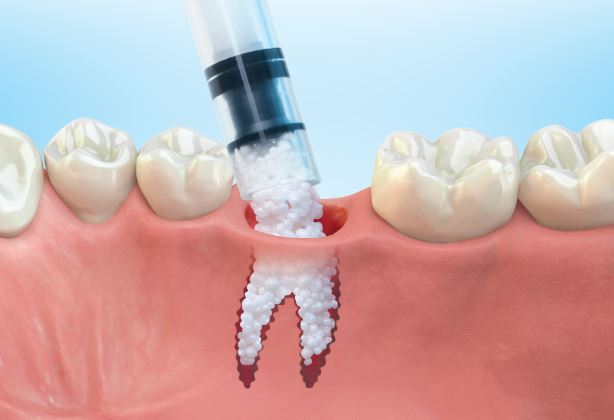Please Visit the Forms Page for all Consent Forms
Most dental bone grafting procedures are done to restore your bone to its previous form following tooth loss, gum disease or trauma.
 Following a tooth extraction, the bone heals by filling the socket with new bone. Unfortunately, the level of the fill is always less than the bone level before the extraction. Such bone resorption may result in an unattractive collapsed appearance and may compromise the dentist’s ability to adequately replace the missing tooth with a bridge, implant or dentures. A bone grafting material placed in the extraction site will help support bone formation and help maintain the integrity of the bridge, implant or denture.We use several different graft materials to preserve your jawbone. All are very effective and well tolerated. Your treatment plan will be evaluated to determine the appropriate material for the bone graft. All materials are made of small sand like particles or a thick paste. The material is placed into your tooth socket, bone defect, sinus or other area that needs filled. Occasionally a resorbable membrane may be placed over the graft material to hold and protect it while healing.To prevent the material from dislodging and to help healing, you need to do a few simple things:
Following a tooth extraction, the bone heals by filling the socket with new bone. Unfortunately, the level of the fill is always less than the bone level before the extraction. Such bone resorption may result in an unattractive collapsed appearance and may compromise the dentist’s ability to adequately replace the missing tooth with a bridge, implant or dentures. A bone grafting material placed in the extraction site will help support bone formation and help maintain the integrity of the bridge, implant or denture.We use several different graft materials to preserve your jawbone. All are very effective and well tolerated. Your treatment plan will be evaluated to determine the appropriate material for the bone graft. All materials are made of small sand like particles or a thick paste. The material is placed into your tooth socket, bone defect, sinus or other area that needs filled. Occasionally a resorbable membrane may be placed over the graft material to hold and protect it while healing.To prevent the material from dislodging and to help healing, you need to do a few simple things:
- The day after surgery, begin rinsing with warm salt water three times a day for seven days.
- Do not rise vigorously.
- Do not pick at the site.
- Do not use commercial mouthwash (i.e., Listerine, etc.) for two weeks
- Do not chew on the site.
- Keep your mouth very clean while healing takes place.
- You may carefully brush the areas next to the graft.
- Come in for an appointment if any dental plates or bridges push on or irritate the area.
- Finish taking any antibiotic prescription that you might have been given.
- Please call our office at (812) 482-2280 if you have any questions.
Healing is usually quick and uncomplicated. Sutures, if not absorbable, are removed in 1-2 weeks. It is normal for a few small pieces of the graft to work out through your gum during healing. Temporary bridges and plates can be worn immediately in most cases. Permanent bridge construction may be done in 2-3 months. If dental implants are part of your treatment plan, additional healing time is usually required before implant placement can be performed.
We will file your insurance for this nationally recognized procedure. Unfortunately many insurance carriers do not yet pay for this procedure. On the day of surgery, you are responsible for your share and any charges your insurance carrier does not pay. Talk to your insurance carrier and encourage them to support this simple and effective way to preserve your bone and long-term dental health.

